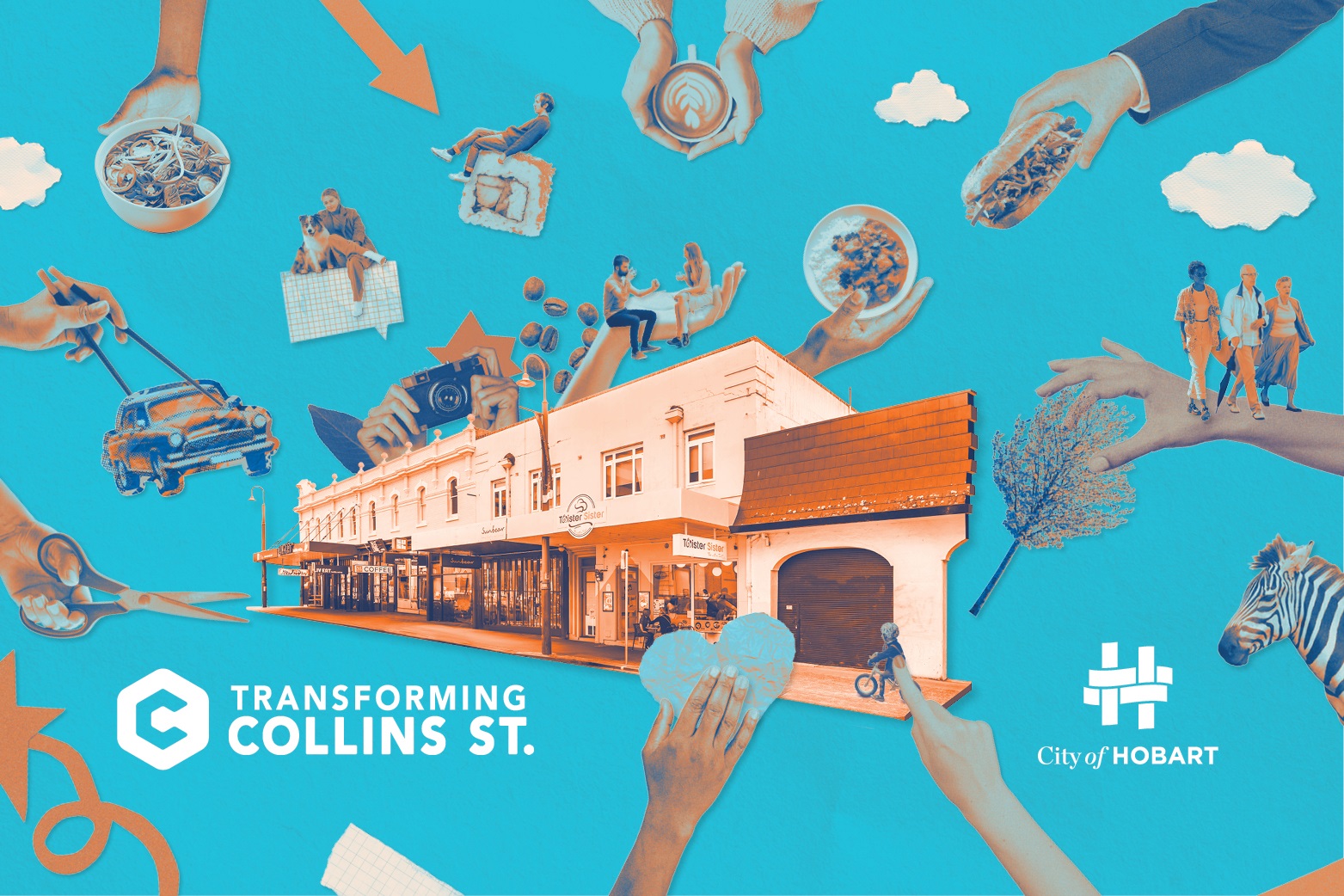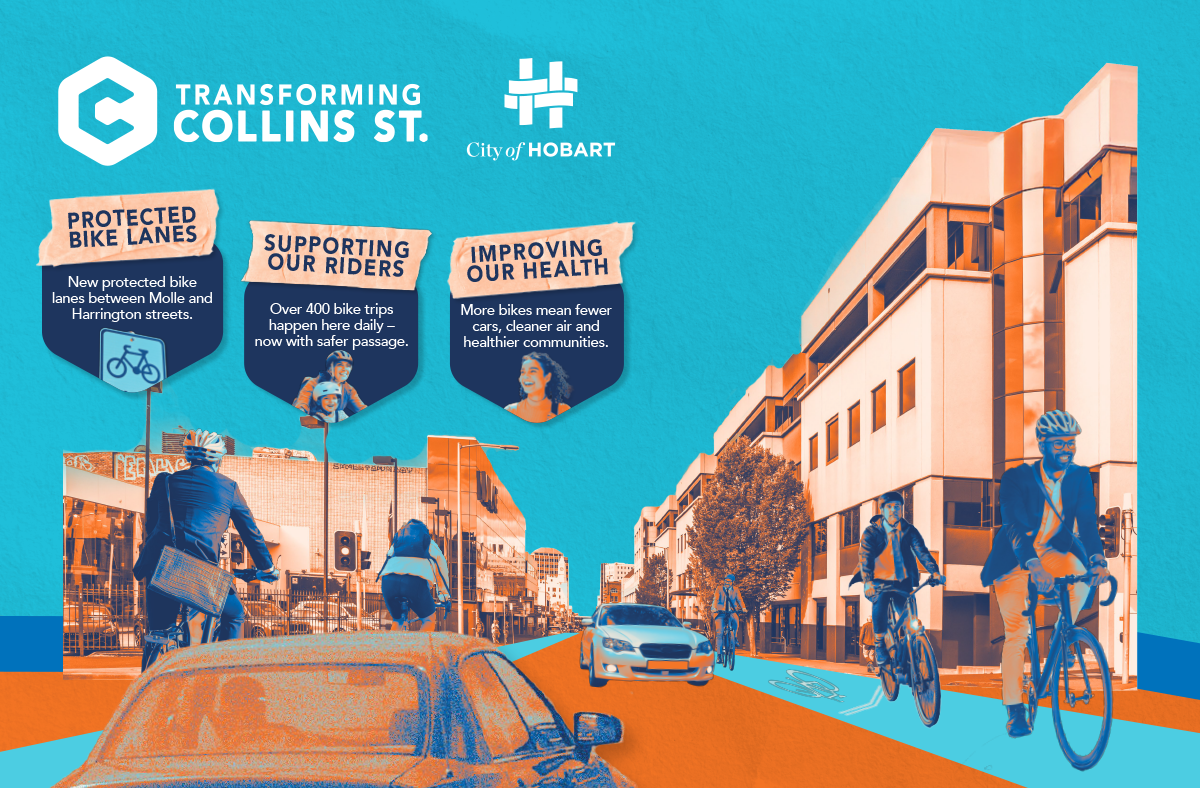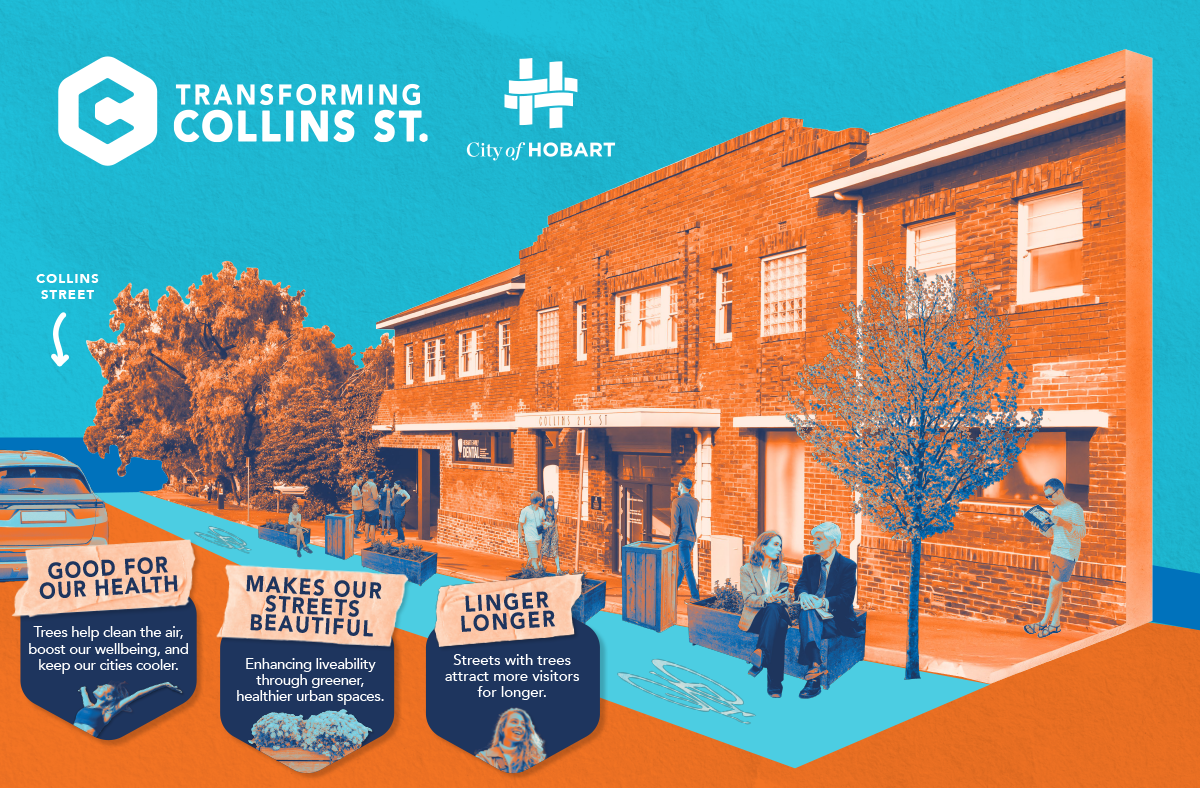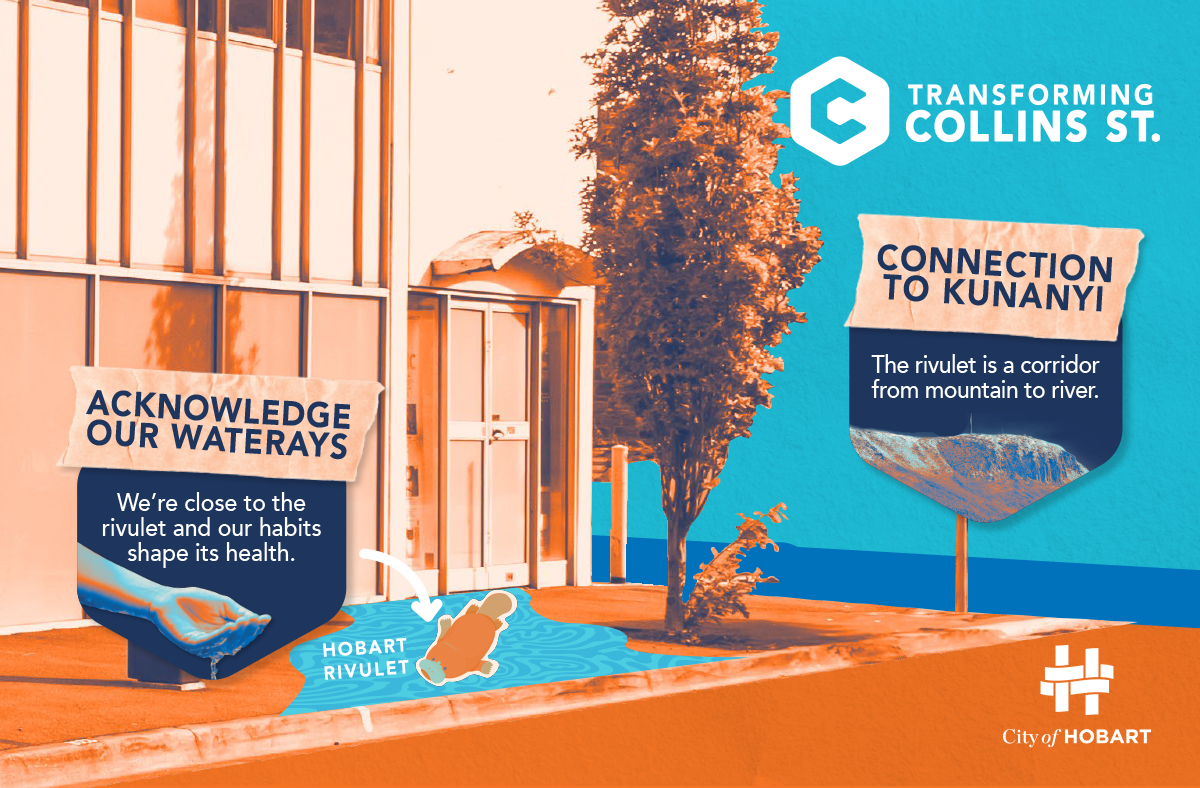Transforming Collins Street

Transforming Collins Street is an ongoing project which involves a variety of tactical trial changes. They include streetside dining areas and separated cycling lanes, on one of Hobart's great streets.
It is another small step in a long-running ambition to create unique, lively urban spaces across Hobart. These spaces encourage people to linger longer.
The changes look to enhance the connection between the city's busy CBD and the popular Hobart Rivulet Track.
Some on-street parking has been converted to accommodate on-street dining areas and cycling lanes. However, there are still parking spots and loading zones on each block in the project area.
The project, which was endorsed by Hobart City Council in September 2024, is a two-year trial which is being reviewed at regular intervals.
What does it involve?
The project area is a 700-metre stretch of Collins Street. It runs from the Molle Street intersection through to the Murray Street intersection at the edge of the CBD.
This area has been equipped with a mix of:
- streetside dining areas
- separated bicycle lanes
- additional accessible parking spaces
- street plantings
- greening
- lower speed limits
- a new zebra crossing.
Here are some additional details about some of the key street treatments being trialled as part of the project:
Streetside dining
Hobartians looking to enjoy a bite in the fresh air can use this new dining deck to soak up the city buzz. It's located just near the intersection of Collins and Harrington streets.
The space aims to bring life and energy to a strip of much-loved cafes and restaurants. It's lined with colourful furniture, leafy greenery and eye-catching umbrellas.
There's also a clear gap between the dining space and the building line, which means it meets accessibility requirements.
It's a shared community space, so anyone is welcome to bring their own lunch and grab a seat at one of the tables.
Some restaurants will even serve you out on the deck – just pop your head in and let them know you're out there!

Separated cycle lanes
Protected bike lanes now run along both sides of Collins Street between Molle and Harrington streets.
These lanes are separated from cars to make riding more comfortable and encourage more people to hop on a bike.
Nearly 40 per cent of Tasmanians are interested in cycling but feel worried about riding alongside traffic. Separated lanes are one of the most effective ways to build confidence.
Even before this trial began, more than 400 bike trips were being taken on Collins Street every day. We're hoping this number will grow.
More bike trips means fewer cars on the road, lower emissions, and healthier communities.

Zebra crossing
If you've wandered down Collins Street recently, you might've noticed the new zebra crossing near Victoria Street.
It's been installed in a popular section of the street to give people a quicker way to cross the road - with pedestrians being given priority.
It's also a helpful visual reminder for drivers to slow down and keep an eye out for people walking through the area.

Lower speed limits
We're slowing things down on Collins Street to make it safer and more comfortable for everyone.
The speed limit is now 40km/h between Molle and Harrington streets, and 30km/h from Harrington to Murray streets. That's where there's more foot traffic and street activity.
Why does it matter? A person hit by a car travelling 50km/h has less than a 50 per cent chance of surviving. At 40km/h, that jumps to over 70 per cent and it's even safer at 30km/h.
Lower speeds help create a calmer, more people-friendly street - one that's easier to walk, ride, and relax in.

Street greening
Planter boxes with trees have been installed along parts of the footpath throughout the trial area. They add some fresh greenery to the street.
Plants do more than just look good. They act as natural air filters, help cool the city in summer and are great for our mental wellbeing.
They also help create a more welcoming, beautiful street. Research shows people tend to linger longer and visit more often in leafy spaces.

Highlighting our rivulet
It's easy to forget that the Hobart Rivulet doesn't end at the edge of the city. It actually winds beneath our feet through underground tunnels and flows all the way to the River Derwent.
To highlight this hidden feature, we've painted the footpath blue where the rivulet crosses under Collins Street. This is between Barrack and Molle streets.
You can find other references to the rivulet spread throughout the CBD. There are art works, sculptures, and openings that let you see the water and footpath paving designs.
It's a simple reminder of our connection to nature, to Kunanyi / Mt Wellington, and to the precious wildlife that depend on the health of our waterways.

Parking changes
To make room for the new dining deck and cycle lanes, some on-street parking spaces have been removed.
But there are still parking bays and loading zones on every block of Collins Street. There are also more than 1000 parking spaces in the immediate area.
As part of the trial, we've also doubled the number of accessible parking spaces on the street from two to four.

Bus Boarder trial
Collins street is home to a busy bus stop for several different transport services.
A bus boarder, similar to a tram platform you would see in other major cities, aims to provide the users of the area a shared space of the bicycle path and footpath for all users of the road and footpath.
This Platform Bus Stop, between Victoria Street and Murray Street, will see that buses stop in the vehicle travel lane and not at the kerb. A raised bicycle lane between the footpath and travel lane allows pedestrians to move safely across the raised platform to board public transport.
Sharing the space and keeping people safe means all vehicles, including bicycles, must stop behind the bus while it is stationary.
Relevant road rules
To ensure safe and respectful sharing of space, the following road rules apply:
- RR 250(2)(b): "The rider of a bicycle on a footpath or a shared path must give way to any pedestrian on the footpath or shared path."
- RR 239(3): "A pedestrian who is crossing a bicycle path, or a part of a separated footpath designated for the use of bicycles, must keep out of the path of any bicycle…"
Design reference
This arrangement is referred to as a Platform Bus Stop in the Tasmanian Government's Cycling Infrastructure Design Guide (Section 4.4.4).

Example of Bus Boarder site on Hunter Street, Newcastle
Changes are also planned for the block between Victoria and Murray streets, but this section hasn't been installed yet.
It was approved later than the rest of the project and will be rolled out in early 2026.
How do I share my thoughts?
We are keeping a close eye on how the Collins Street trial is going. We also want your input to help shape what happens next.
Over the course of the two-year project, we're collecting feedback from the community. We're also tracking how many people are using the bike lanes, dining deck, and other features.
All the feedback and data we gather is helping us understand what's working, what could be improved, and how the street is being used.
We are sharing summaries of each engagement stage on the YourSay page so everyone can stay up to date.
Engagement stage 1 (concluded)
Our first engagement phase ran from 28 February to 16 March 2025, before the trial was installed.
During the time, Hobartians shared their thoughts by filling out a survey on YourSay, attending drop-in sessions on Collins Street and chatting with council officers across the project area.
The feedback gathered during this phase has been summarised and is available on the YourSay page.

Engagement stage 2 (concluded)
After changes had been in place for about one month, we listened to what Hobartians thought about the trial.
We ran a survey via Your Say as well as hosting drop-in sessions outside 188 Collins Street where council staff were available to chat about the changes.
Throughout the engagement period, we also walked along the street at various times to conduct face-to-face surveys with people using the area and the new additions.
From these engagements we created a one-month post installation monitoring report for Stage 2 of this project.

Engagement stage 3 (open)
The Three-months Post-Installation Engagement for this project is now currently open, from 7 to 23 November 2025.
Have your say:
Your Say Hobart
Engagement stage 4 (upcoming)
More details will be available in May 2026.
Engagement stage 5 (upcoming)
More details will be available in May 2027.
Victoria to Murray streets update (July 2025)
The original Council resolution from 2024 removed all parking in the block between Victoria and Murray Street. This was revisited by Council following feedback from stakeholders. A resolution at the 31 March 2025 Council meeting determined that the previously advertised trial design between Victoria and Murray Street would be replaced with a new design. The new design retained:
- vehicle parking on one side of the street ("Mountain Bound") with a protected bicycle lane
- the "in lane" bus stop on the other side of the Street ("City Bound").

Victoria to Murray streets map(PNG, 451KB)
These changes between Victoria Street and the Murray Street intersection will occur later in 2025.
What is the project timeline?
Please note: Some dates in this timeline are indicative only and could differ depending on varying circumstances.
Two-year tactical trial endorsed by Hobart City Council.
Stage 1 engagement with Collins Street users.
Installation of bicycle lanes, street-side dining and other project infrastructure over a six-week period.
Stage 2 engagement with Collins Street users.
Stage 3 engagement with Collins Street users.
Stage 4 engagement with Collins Street users.
Conclusion of trial. Stage 5 engagement with Collins Street users.
Findings and future options to be presented before Hobart City Council.
Frequently asked questions (FAQs)
Why are we doing this?
All cities change over time. We are working hard to create vibrant, safe linkages between the key areas across our city.
In recent years, we have:
- significantly upgraded retail precincts throughout Hobart
- helped to transform Liverpool Street into a business and street dining hub
- installed a new pedestrian and cycle bridge connecting the city to the University Rose Garden and the Queens Domain.
The area around Collins Street has recently become the subject of significant, medium-density development proposals.
The recently adopted Central Hobart Plan has identified the need to support this growth by improving linkages to the CBD and natural areas like the Hobart Rivulet. It also identified the need to improve the general amenity of the area with street-side dining and additional greening.
Giving people greater options in how they move along Collins Street, including by bike and on foot, is also important. Our designs are aimed at ensuring people have safe and efficient routes, with some streets being prioritised for specific modes of transport.
A lower speed environment, streetside dining, a new pedestrian crossing and street greening will create a more comfortable, inviting environment for people walking and spending time on Collins Street. This is good for business and good for our city.
What is the background behind this project?
Improving the amenity of Collins Street for pedestrians, cyclists and businesses has been a long-term vision for the City. The ambition has been outlined in various plans and strategies over the past two decades.
The street was identified as a future arterial cycleway in the Hobart Regional Arterial Bicycle Network 2009.
Plans to improve active travel along Collins Street were then highlighted in the 2011 Hobart Rivulet Park Strategic Master Plan.
In 2012, linking the rivulet to the CBD through Collins Street was listed as a "priority project" in the Inner City Action Plan.
The need to strengthen Collins Street for walking and cycling, to support medium-density development, was then identified in the Central Hobart Plan in 2023.
Off the back of this strategic planning, a concept plan for the tactical trial was produced before eventually being presented and endorsed at the Council Meeting on 27 May 2024.
The City of Hobart engaged with business owners along Collins Street and, because of feedback, made multiple changes to the proposed design to retain more car parks and loading zones.
The updated design was presented before Hobart City Council at the Council Meeting on 16 September 2024, with councillors endorsing the two-year trial.
The Tasmanian Government then withdrew its commitment to help fund the project, causing the Hobart City Council to resolve to use project contingency funds to cover the funding shortfall at the Council Meeting on 14 October 2024.
The project appeared before the councillors again at the Council Meeting on 11 November 2024, where it was resolved that the project would be paused between Victoria and Murray St to explore options to "retain loading zone and parking opportunities".
Following an engagement process, options for the design of the trial between Victoria and Murray St were presented to councillors at the Council Meeting on 31 March 2024, where it was resolved that a design which included a protected bicycle lane on the northern side of the street with parking and a loading zone on the southern side of the street would be trialled.
Where will I park?
Collins Street, between Molle and Harrington streets, will still have:
- 25 on-street parking spots
- two accessible parking spaces
- four loading zones.
Between Harrington and Murray streets, there will be 10 parking spaces and two accessible parking spots.
There are more than 1000 parking spaces within the immediate vicinity of Collins Street. This includes both on and off-street parking. This trial will see a 2 per cent reduction to public parking in the area.
There are five side streets which come off Collins Street which have roughly 150 on-street car parks within one block of the project area. This includes Molle, Barrack, Harrington, Victoria and Murray streets.
There are also over 100 spaces, including eight accessible parking spaces, in the Village Cinemas car park on Collins Street.
The Centrepoint Car Park is located next to Collins Street and has 780 car parks. It is rarely at full occupancy.
How will the trial impact traffic flow?
We engaged Pitt and Sherry to undertake traffic modelling of the proposed changes.
The findings of this modelling showed that there would be a slight increase in delay for vehicles at some Collins Street junctions.
The traffic modelling was presented at the Council meeting in September 2024 and is publicly available.
It is important to understand that Collins Street is not a strategic traffic route for through vehicle movements. There are several other streets around the city that do prioritise vehicle movements. This includes Macquarie, Davey, Barrack, Bathurst, Brisbane streets.
Will people use the bicycle lanes?
The Greater Hobart Household Travel Survey 2023 was conducted by the Tasmanian Government. It showed there is a rising number of cyclists in Hobart.
It found there were 4800 trips completed on bikes within the City of Hobart local government area each day. This is a 50 per cent increase since 2019.
Hobartians riding bikes is good for their health and good for motorists. It results in less cars on the road and helps traffic flow better.
We know the number one barrier to more people taking up cycling or any form of active transport is safety, something which separated cycle lanes will help address.
Data shows between 350 to 450 bicycle trips were conducted on Collins Street each weekday prior to the trial. This depended on the count location along the corridor.
How will we measure success?
The trial will be carefully monitored at key intervals across the two-year trial.
The seven key metrics which will be measured during the trial are:
- The number of bike and micromobility users using the street (targeting an increase in riders)
- The diversity of users of the street (targeting an increase in the proportion of women, children and types of bicycles)
- The number of people crossing the street (targeting an increase in people crossing from one side of Collins Street to the other)
- The speed of vehicles driving on the street (targeting reduced vehicle speeds)
- Perceived safety (targeting an increase for people walking and riding)
- Feedback from local stakeholders (targeting net positive sentiment towards the project)
- Feedback from broader stakeholders (targeting net positive sentiment towards the project)
The 'Monitoring & Evaluation Framework' outlines how we will track these metrics. It is available on the project's YourSay page.
How can I keep up-to-date on the project?
We will make regular updates to this webpage, and directly to our project mailing list at key milestones:
Subscribe
Location
Collins Street, Hobart 7000 View Map
-42.8833771,147.3272791
Collins Street ,
Hobart 7000
Collins Street ,
Hobart 7000
Transforming Collins Street